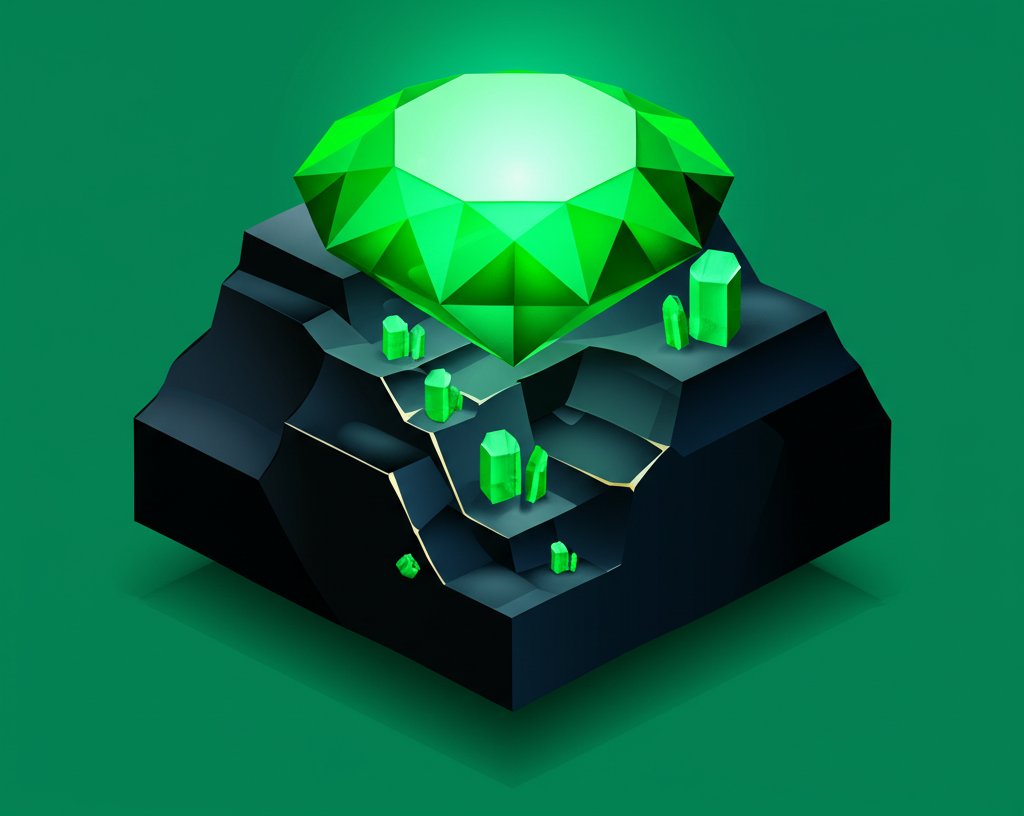Welcome, fellow enthusiasts of the extraordinary! As a seasoned gemologist with years immersed in the captivating realm of precious gems, I invite you on an exclusive journey to uncover the profound emerald properties that have captivated royalty, artists, and collectors for millennia. Among all gemstones, the emerald holds a place of unparalleled prestige, celebrated for its vibrant green hue and intrinsic allure. This article is your definitive guide, delving deeper than ever before into the geological wonders, scientific intricacies, and expert insights that make emeralds truly unique. Prepare to have their most precious secrets revealed, from their formation deep within the Earth to the nuanced factors that define their exquisite value.
To truly appreciate the allure of emeralds, it helps to understand their unique place amongst all other precious stones, which you can further explore by learning more about gemstone facts and origins.
The Alluring Hue: A Gemologist’s Deep Dive into Emerald Color

When we speak of emeralds, the first image that springs to mind is almost invariably their breathtaking green. But this isn’t just any green; it’s a spectrum, a dance of light and chemistry that creates the most desirable “emerald green.” As a gemologist, I recognize that color is arguably the most critical of all emerald properties, dictating both beauty and value.
Understanding the Spectrum of Emerald Green
The characteristic green of emeralds ranges from a subtle yellowish-green to an intense bluish-green. The most prized color, often referred to as “vivid green” or “grass green,” exhibits a strong, pure green with excellent saturation and medium-dark tone. It’s a color that evokes lush forests and the verdant vitality of nature itself. This superior color is predominantly found in stones from Colombia, particularly the legendary Muzo and Chivor mines, which have historically produced emeralds with an exceptional, almost glowing luminosity.
The Chemistry Behind the Color: Chromophores and Crystallography
What gives emeralds their iconic color? It’s a fascinating tale of trace elements. Emeralds are a variety of the mineral beryl, chemically composed of beryllium aluminum cyclosilicate (Be3Al2(SiO3)6). However, the magic happens with the inclusion of specific chromophores: chromium (Cr3+), vanadium (V3+), and sometimes iron (Fe2+ or Fe3+) within the beryl crystal lattice.
- Chromium and Vanadium: These are the primary color-causing agents. Their presence allows the crystal to absorb specific wavelengths of light, primarily red and yellow, while transmitting the green we adore. The higher the concentration of these elements, and the purer their influence (less iron), the more intense and desirable the green.
- Iron: While iron can also contribute to green in some gemstones, in emeralds, its presence often leads to a more yellowish-green hue or can even mute the vibrant green to a duller tone. A discerning gemologist can often infer the likely geographic origin of an emerald by subtle color nuances influenced by these trace elements. For example, Zambian emeralds often have a higher iron content, contributing to a slightly bluer, richer green compared to Colombian emeralds.
The Role of Light Interaction: Pleochroism and Brilliance
Beyond chemical composition, how light interacts with the crystal structure further enhances the emerald’s color. Emeralds exhibit pleochroism, meaning they display different colors when viewed from different angles. Typically, they show a bluish-green to yellowish-green shift. A skilled cutter or gemologist will orient the rough crystal to ensure that the strongest, most attractive green is visible through the table facet, maximizing its beauty. The natural vitreous luster of a well-polished emerald further enhances its brilliance, allowing light to cascade through its facets and ignite its internal fire.
Unmasking Emerald Clarity and Inclusions: The “Jardin” Phenomenon

Unlike diamonds, where flawless clarity is paramount, emeralds are almost universally characterized by inclusions. These internal features are so common and often so distinctive that they have their own romantic term: “jardin,” French for garden. As a gemologist, I see the jardin not as a flaw, but as the unique fingerprint of each emerald, telling its natural story and confirming its authenticity as a precious gem.
The Intricate World Within: Types of Inclusions
The “garden” inside an emerald can contain a variety of fascinating elements:
Impact on Durability and Value: Eye-Visible vs. Microscopic
While inclusions are inherent to emeralds, their type, size, location, and visibility significantly impact the stone’s durability and value.
Fracture Filling: Enhancing Beauty and Protecting the Stone
Due to the prevalence of surface-reaching fissures, most natural emeralds undergo a clarity enhancement process, typically with colorless oils or resins. This is a universally accepted practice within the precious gems trade.
Beyond Beauty: The Enduring Strength and Unique Challenges of Emerald Hardness
When discussing the emerald properties, its perceived fragility often comes up, yet emeralds possess considerable hardness. It’s the combination of hardness with common inclusions that requires special consideration.
Mohs Scale and Wearability: A Gemologist’s Perspective
Emeralds rate 7.5 to 8 on the Mohs scale of mineral hardness. This places them firmly within the range suitable for daily wear in jewelry, alongside other durable gemstones like quartz (7) and topaz (8). For comparison, diamonds are a 10 and rubies/sapphires are a 9.
The Emerald Cut: Maximizing Beauty, Minimizing Risk
The iconic “emerald cut” (a rectangular or square step cut with clipped corners) was developed specifically for this precious gem.
Practical Implications for Jewelry: Setting and Protection
Given their unique blend of hardness and relative brittleness, emeralds require thoughtful consideration in jewelry design:
The Geological Tapestry: How Emeralds Form and Their Distinctive Chemistry
To truly appreciate emerald properties, we must delve into their geological origins. The formation of these precious gems is a rare and spectacular event, requiring precise conditions that occur in only a few places on Earth.
The Birth of a Beryl: Tectonic Forces and Hydrothermal Veins
Emeralds are a variety of beryl, and their formation is a testament to the powerful, transformative forces deep within the Earth’s crust.
1. Metasomatic Deposits: This is the most common and historically significant type, especially for Colombian emeralds. Hot, chromium-rich fluids (often from shales) interact with beryllium-rich rocks (like pegmatites or granites). This interaction, driven by tectonic plate collisions, creates the perfect environment for beryl to crystallize and absorb the chromophores, forming emeralds in hydrothermal veins.
2. Schist-Hosted Deposits: Found in locations like Zambia and Brazil, these emeralds form when beryllium-rich pegmatites intrude into chromium-bearing schists. The interaction and metamorphism create conditions for emerald growth.
Mineralogical Characteristics: Crystal Habit and Specific Gravity
As a gemologist, I rely on several intrinsic emerald properties to identify and categorize these gemstones.
Geographic Origins and Their Signature Properties
The origin of an emerald can often be inferred by a gemologist based on subtle differences in its emerald properties, particularly color and inclusions:
Evaluating Verdant Treasures: A Gemologist’s Guide to Emerald Value
Determining the value of precious gems like emeralds is a complex art and science, blending objective criteria with market dynamics. As a gemologist, I apply a rigorous methodology, prioritizing the traditional “4 Cs” but with specific considerations tailored to emerald properties.
The 4 Cs of Emerald Evaluation: Color, Clarity, Cut, and Carat Weight
While the same framework applies, the emphasis shifts for emeralds:
Color (The Foremost Driver): As discussed, color is king. The most valuable emeralds possess a highly saturated, vivid green with a medium to medium-dark tone, often with a slight bluish secondary hue. Purity of color, free from excessive yellowish or grayish modifiers, is paramount. A gemologist meticulously assesses this.
Clarity (The Accepted Imperfection): Unlike diamonds, an emerald does not need to be flawless to be valuable. In fact, a clean emerald raises suspicion and might indicate it’s a synthetic or another gemstone. The key is that inclusions should not be disruptive to the stone’s beauty or severely compromise its durability. Eye-clean is desirable but rare. A gemologist looks for transparency and a charming, non-detracting jardin.
Cut (Maximizing Beauty and Protecting Integrity): The cut influences brilliance, color optimization, and the stone’s structural integrity. A well-proportioned cut maximizes light return and presents the best face-up color. The aforementioned emerald cut is generally preferred for its protective qualities and ability to showcase the stone’s natural beauty. Poorly cut emeralds appear dull or windowed.
Carat Weight (Size Matters, But Not Always Most): Larger emeralds are rarer, and their price per carat increases exponentially. However, a small, vibrant, high-clarity emerald will almost always be more valuable than a large, dull, heavily included one. For precious gems, quality often trumps sheer size.
Beyond the 4 Cs: Treatment, Origin, and Rarity
Several other emerald properties significantly influence value:
- Treatment: As natural emeralds typically have inclusions, most are treated with oil or resin to improve clarity. While accepted, the type and extent of treatment must be disclosed. “Minor” or “moderate” oiling is generally acceptable. Heavy resin treatments can reduce value compared to lightly oiled stones. Untreated, high-quality emeralds are exceptionally rare and fetch the highest prices. This is a critical factor for a gemologist to assess and disclose.
- Origin: As detailed previously, Colombian emeralds (especially from Muzo, Chivor, and Coscuez) command a premium due to their historical prestige and often superior color. Other origins like Zambia and Brazil also produce beautiful stones with distinct characteristics, each valued according to its specific emerald properties.
- Rarity and Demand: The overall rarity of high-quality emeralds drives their status as highly sought-after precious gems. Market demand, historical significance, and designer preference also play a role.
Caring for Your Emeralds: Expert Tips for Longevity
Owning an emerald is a privilege, and proper care is essential to preserve its beauty and value for generations. As a gemologist, I can’t stress enough the importance of understanding the unique emerald properties when it comes to maintenance.
Handling and Storage: Gentle Care is Key
- Avoid Impact: Due to their relative brittleness, always remove emerald jewelry before engaging in activities that could subject them to hard knocks or abrasions (e.g., gardening, sports, household chores).
- Separate Storage: Store emerald jewelry separately from other gemstones and metal jewelry. Harder stones (like diamonds or sapphires) can easily scratch an emerald, while metal can cause scuffs. A soft pouch or a separate compartment in a jewelry box is ideal.
- Protect from Extreme Heat: Sudden changes in temperature can cause filler materials to dry out or even for the stone to fracture. Avoid exposing emeralds to intense heat sources.
Cleaning Emeralds: A Gemologist’s Prescribed Method
The best way to clean emeralds accounts for their natural inclusions and often present treatments.
Ultrasonic Cleaners: Absolutely avoid these! The vibrations can dislodge filler materials, worsen existing fractures, or even cause new ones.
Steam Cleaners: The high heat and pressure are disastrous for emeralds and their treatments.
* Harsh Chemicals: Alcohol, ammonia, or abrasive cleaners can strip oils, damage treatments, or react with the stone itself.
Re-Oiling: When and Why
Over time, the natural oils used to enhance emeralds may dry out, causing inclusions to become more visible.
Conclusion: The Enduring Legacy of Emeralds
From the ancient mines of Cleopatra to the modern runways, emeralds have always symbolized rebirth, love, and royalty. As a gemologist, I’ve had the privilege of examining countless examples of these extraordinary precious gems, each with its own story etched in its internal garden. The unique emerald properties—their mesmerizing color, distinct inclusions, remarkable hardness, and specific geological origins—combine to create a gemstone of unparalleled character and allure.
By understanding the intricate details of how these gemstones are formed, what gives them their exceptional beauty, and how to properly care for them, you gain a deeper appreciation for their true value. Whether you’re a collector, a designer, or simply an admirer, the secrets of the emerald are now unveiled before you. Embrace the magic, cherish the history, and protect the enduring legacy of Earth’s verdant treasures.
FAQ – Your Questions Answered by a Gemologist
What makes an emerald a “precious gem”?
Emeralds are classified as precious gems due to their rarity, beauty, durability (despite inclusions), and historical significance. Along with diamonds, rubies, and sapphires, they hold a distinguished place in the world of fine gemstones. Their unique vivid green color, caused by trace elements like chromium and vanadium, is highly prized and uncommon in other gem varieties.
How do emerald properties affect their value compared to other gemstones?
Emerald properties significantly influence their value. While diamonds prioritize clarity and lack of color, emeralds are primarily valued for their intense, vivid green color. Clarity, while still important, is assessed differently due to the common “jardin” inclusions. A vibrant color often outweighs minor inclusions in emerald valuation, a nuanced approach a gemologist would apply.
Can a gemologist identify if an emerald is natural or synthetic?
Yes, a skilled gemologist can definitively identify whether an emerald is natural or synthetic using specialized equipment and their knowledge of emerald properties. Natural emeralds typically contain characteristic inclusions (like three-phase inclusions) and growth patterns not found in synthetics. Synthetics often show different growth structures, gas bubbles, and distinct optical properties.
What is the most important property when evaluating an emerald?
For a gemologist, color is generally considered the most important of all emerald properties. A vivid, highly saturated pure green with good transparency will command the highest value, even if it has some acceptable inclusions. While clarity, cut, and carat weight are crucial, a weak or off-color emerald will rarely be highly valued, regardless of other factors.
Are emeralds durable enough for everyday wear?
Emeralds have a hardness of 7.5 to 8 on the Mohs scale, making them resistant to scratches. However, due to their natural inclusions and relatively lower toughness compared to diamonds or sapphires, they are prone to chipping or breaking if subjected to hard knocks. A gemologist recommends wearing emerald jewelry with care and removing it during strenuous activities to ensure its longevity.
Why do most natural emeralds have inclusions?
Emeralds form under specific geological conditions involving the interaction of different elements and fluids deep within the Earth’s crust. During this growth process, tiny pockets of gas, liquid, or other mineral crystals can become trapped within the beryl crystal, forming the characteristic inclusions known as “jardin.” These inclusions are a natural part of most emerald properties and are rarely absent in natural stones.
What treatments are common for emeralds and how do they affect value?
The most common treatment for emeralds is oiling or resin filling. This involves introducing a colorless oil or resin into surface-reaching fissures to improve the stone’s clarity and enhance its appearance. This is a widely accepted practice for precious gems. A gemologist will classify the extent of treatment (minor, moderate, significant). Heavily treated stones or those with unstable fillers may be valued lower than lightly treated or untreated emeralds, which are very rare and command the highest prices.
“@context”: “https://schema.org”,
“@type”: “FAQPage”,
“mainEntity”: [
“@type”: “Question”,
“name”: “What makes an emerald a \”precious gem\”?”,
“acceptedAnswer”: {
“@type”: “Answer”,
“text”: “Emeralds are classified as precious gems due to their rarity, beauty, durability (despite inclusions), and historical significance. Along with diamonds, rubies, and sapphires, they hold a distinguished place in the world of fine gemstones. Their unique vivid green color, caused by trace elements like chromium and vanadium, is highly prized and uncommon in other gem varieties.”
“@type”: “Question”,
“name”: “How do emerald properties affect their value compared to other gemstones?”,
“acceptedAnswer”: {
“@type”: “Answer”,
“text”: “Emerald properties significantly influence their value. While diamonds prioritize clarity and lack of color, emeralds are primarily valued for their intense, vivid green color. Clarity, while still important, is assessed differently due to the common \”jardin\” inclusions. A vibrant color often outweighs minor inclusions in emerald valuation, a nuanced approach a gemologist would apply.”
“@type”: “Question”,
“name”: “Can a gemologist identify if an emerald is natural or synthetic?”,
“acceptedAnswer”: {
“@type”: “Answer”,
“text”: “Yes, a skilled gemologist can definitively identify whether an emerald is natural or synthetic using specialized equipment and their knowledge of emerald properties. Natural emeralds typically contain characteristic inclusions (like three-phase inclusions) and growth patterns not found in synthetics. Synthetics often show different growth structures, gas bubbles, and distinct optical properties.”
“@type”: “Question”,
“name”: “What is the most important property when evaluating an emerald?”,
“acceptedAnswer”: {
“@type”: “Answer”,
“text”: “For a gemologist, color is generally considered the most important of all emerald properties. A vivid, highly saturated pure green with good transparency will command the highest value, even if it has some acceptable inclusions. While clarity, cut, and carat weight are crucial, a weak or off-color emerald will rarely be highly valued, regardless of other factors.”
“@type”: “Question”,
“name”: “Are emeralds durable enough for everyday wear?”,
“acceptedAnswer”: {
“@type”: “Answer”,
“text”: “Emeralds have a hardness of 7.5 to 8 on the Mohs scale, making them resistant to scratches. However, due to their natural inclusions and relatively lower toughness compared to diamonds or sapphires, they are prone to chipping or breaking if subjected to hard knocks. A gemologist recommends wearing emerald jewelry with care and removing it during strenuous activities to ensure its longevity.”
“@type”: “Question”,
“name”: “Why do most natural emeralds have inclusions?”,
“acceptedAnswer”: {
“@type”: “Answer”,
“text”: “Emeralds form under specific geological conditions involving the interaction of different elements and fluids deep within the Earth’s crust. During this growth process, tiny pockets of gas, liquid, or other mineral crystals can become trapped within the beryl crystal, forming the characteristic inclusions known as \”jardin.\” These inclusions are a natural part of most emerald properties and are rarely absent in natural stones.”
“@type”: “Question”,
“name”: “What treatments are common for emeralds and how do they affect value?”,
“acceptedAnswer”: {
“@type”: “Answer”,
“text”: “The most common treatment for emeralds is oiling or resin filling. This involves introducing a colorless oil or resin into surface-reaching fissures to improve the stone’s clarity and enhance its appearance. This is a widely accepted practice for precious gems. A gemologist will classify the extent of treatment (minor, moderate, significant). Heavily treated stones or those with unstable fillers may be valued lower than lightly treated or untreated emeralds, which are very rare and command the highest prices.”










